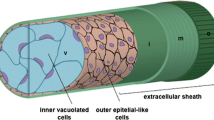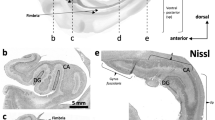Summary
-
1.
InTriturus cristatus embryos (Harrison stages 15–42) the development of cholinesterase (ChE) activity in the axial mesoderm was investigated.
-
2.
After embedding in polyethylene glycol the histochemical technique of Karnovsky and Roots (preincubation in maleinimid to block sulfhydryl groups) and that of Koelle were employed on serial sections.
-
3.
In early neurula stage ChE is found in the presumptive notochordal and somite material of the archenteron roof.
-
4.
The notochord is ChE-positive from late neurula stage until Harrison stage 25. Then the cells loose their activity in cranio-caudal progression.
-
5.
The subnotochordal rod is ChE-positive from Harrison stage 21/22 until Harrison stage 30–33.
-
6.
The somites are ChE-positive as they develop.
-
7.
During the formation of myotomes, beginning in the cranial part of the embryo the amount of ChE in the engaged somite cells increases. At this time (Harrison 24–26) ChE-negative somites are found in the caudal part of the embryo. These somites become ChE-positive before they change into myotomes.
-
8.
From the beginning the whole myoblasts are ChE-positive. Beginning with Harrison stage 35 the activity concentrates at the ends of the myoblasts near the segmental border. At this time a strong activity in the motor cells of the neural tube appears.
Zusammenfassung
-
1.
Die Entwicklung der Cholinesterase-Aktivität im axialen Mesoderm vonTriturus cristatus von der Neurula bis zur schwimmenden Larve mit zwei Zehen (Harrison-Stadium 15–42) wurde histochemisch untersucht.
-
2.
Nach Einbettung der Keime in Polyäthylenglykol wurde der ChE-Nachweis an Serienschnitten nach Karnovsky und Roots (nach Blockierung der Sulfhydrylgruppen mit Maleinimid) und mit der Koelle-Methode durchgeführt.
-
3.
Im Stadium der offenen Neurula konnte die ChE im Urdarmdach im präsumptiven Chorda- und Somitenmaterial nachgewiesen werden.
-
4.
Die Chorda ist vom späten Neurula- bis zum mittleren Schwanzknospenstadium (Harrison-Stadium 25) in ihrer ganzen Länge ChE-positiv. Anschließend verschwindet die ChE-Aktivität von cranial nach caudal fortschreitend aus der Chorda.
-
5.
Die Hypochorda zeigt vom Beginn ihres Auftretens im Harrison-Stadium 21/22 an eine außerordentlich starke ChE-Aktivität, die sich im Stadium 30–33 wieder verliert. Bald darauf läßt sich die Hypochorda histologisch nicht mehr erkennen.
-
6.
Die einzelnen Somiten sind bei ihrer Entstehung ChE-positiv.
-
7.
Mit der cranial einsetzenden Ausbildung der Myotome steigt die ChE-Aktivität in den beteiligten Somitenzellen stark an. Zu diesem Zeitpunkt (Harrison-Stadium 24–26) sind caudal regelmäßig ChE-negative Somiten anzutreffen. Mit ihrer Umwandlung in Myotome tritt in ihnen wieder eine ChE-Aktivität auf. Sie setzt am dorsomedialen Somitenrand ein.
-
8.
Die ChE-Aktivität in den Myoblasten erstreckt sich zunächst über die gesamte Zelle. Vom Harrison-Stadium 35 an konzentriert sie sich an den Enden der Myoblasten im Bereich der Segmentgrenzen. Gleichzeitig mit der starken Aktivität in den Myoblasten tritt eine ChE-Aktivität in den motorischen Vorderhornzellen im Neuralrohr auf.
Similar content being viewed by others
Literatur
Boell, E. J., Greenfield, P., Shen, S. C.: Development of cholinesterase in the optic lobes of the frog (Rana pipiens). J. exp. Zool.129, 415–453 (1955).
—, Shen, S. C.: Development of cholinesterase in the central nervous system of Amblystoma punctatum. J. exp. Zool.113, 583–599 (1950).
Brachet, J.: La localisation des protéines sulfhydrilées pendant le développement des Amphibiens. Bull. Acad. roy. Belg. 499–510 (1938).
Drews, U.: Über das Verhalten der Esterase- insbesondere der Cholinesteraseaktivität in der Nebennierenregion der Ratte während der Fetalzeit. Histochemie4, 514–530 (1965).
—, Kussäther, E., Usadel, K. H.: Histochemischer Nachweis der Cholinesterase in der Frühentwicklung der Hühnerkeimscheibe. Histochemie8, 75–89 (1967).
Fredricsson, B., Fuxe, K., Holmstedt, B., Sjöquist, F.: Preservation of Cholinesterase and its histochemical demonstration after freeze-drying and polyethylene glycol embedding. Acta morph. neerl. scand.3, 107–114 (1960).
Glaesner, L.: Normentafel zur Entwicklungsgeschichte des gemeinen Wassermolches (Molge vulgaris). In: F. Keibel, Normentafeln zur Entwicklungsgeschichte der Wirbeltiere, H. 14, S. 1–49. Jena: Gustav Fischer 1925.
Harrison, R. G.: Organization and development of the embryo, ed. by S. Wilens. New Haven and London: Yale University Press 1969.
Karnovsky, M. J., Roots, L.: A “direct coloring” thiocholine method for cholinesterases. J. Histochem. Cytochem.12, 219–221 (1964).
Kiszely, G., Posalaky, Z.: Mikrotechnische und histochemische Untersuchungsmethoden. Budapest: Akademiai Kiado 1964.
Kocher, W.: Vakuolisierung der Chorda dorsalis und Wirkung extrachordaler Defekte auf die Differenzierung von Chorda- und Neuralstrukturen bei Triton alpestris. Wilhelm Roux' Arch. Entwickl.-Mech. Org.149, 443–503 (1957).
Kussäther, E., Drews, U., Usadel, K. H.: Histochemischer Cholinesterase-Nachweis während der Abfaltungsbewegungen des Hühnerembryos. Wilhelm Roux' Arch. Entwickl.-Mech. Org.161, 147–161 (1968).
—, Usadel, K. H., Drews, U.: Cholinesterase-Aktivität bei der Entstehung und Auflösung der Somiten des Hühnchens. Histochemie8, 237–247 (1967).
Mumenthaler, M., Engel, W. K.: Cytological localization of cholinesterase in developing chick embryo sceletal muscle. Acta anat. (Basel)47, 274–299 (1961).
Rotmann, E.: Die Bedeutung der Zellgröße für die Entwicklung der Amphibienlinse. Wilhelm Roux' Arch. Entwickl.-Mech. Org.140, 124–156 (1940).
Sawyer, C. H.: Cholinesterase and the behaviour problem in Amblystoma. I. The relationship between the development of the enzyme and early motility. II. The effects of inhibiting cholinesterase. J. exp. Zool.92, 1–29 (1943a).
—: Cholinesterase and the behaviour problem in Amblystoma. III. The distribution of cholinesterase in nerve and muscle throughout development. IV. Cholinesterase in nerveless muscle. J. exp. Zool.94, 1–28 (1943b).
Shen, S. C.: Changes in enzymatic patterns during development. In: The chemical basis of development, p. 416–432. Baltimore: The Johns Hopkins Press 1958.
—, Greenfield, P., Sippel, T.: Application of histochemical technic for cholinesterase to paraffin sections. Proc. Soc. exp. Biol. (N.Y.)81, 452–455 (1952).
Usadel, K. H., Drews, U., Kussäther, E.: Cholinesteraseaktivität im Primitivknoten, in der Schwanzknospe und bei der Chordaentwicklung des Hühnchens. Histochemie8, 219–236 (1967).
Vogt, W.: Gestaltungsanalyse am Amphibienkeim mit örtlicher Vitalfärbung. II. Gastrulation und Mesodermbildung bei Urodelen und Anuren. Wilhelm Roux' Arch. Entwickl.-Mech. Org.120, 384–706 (1929).
Youngstrom, K. A.: On the relationship between choline esterase and the development of behavior in amphibia. J. Neurophysiol.1, 357–363 (1938).
Zacks, S. I.: Esterase in the early chick embryo. Anat. Rec.118, 509–537 (1954).
Author information
Authors and Affiliations
Rights and permissions
About this article
Cite this article
Kocher-Becker, U., Drews, U. Histochemischer Cholinesterase-Nachweis im axialen Mesoderm vonTriturus cristatus . W. Roux' Archiv f. Entwicklungsmechanik 165, 163–173 (1970). https://doi.org/10.1007/BF00650144
Received:
Issue Date:
DOI: https://doi.org/10.1007/BF00650144




